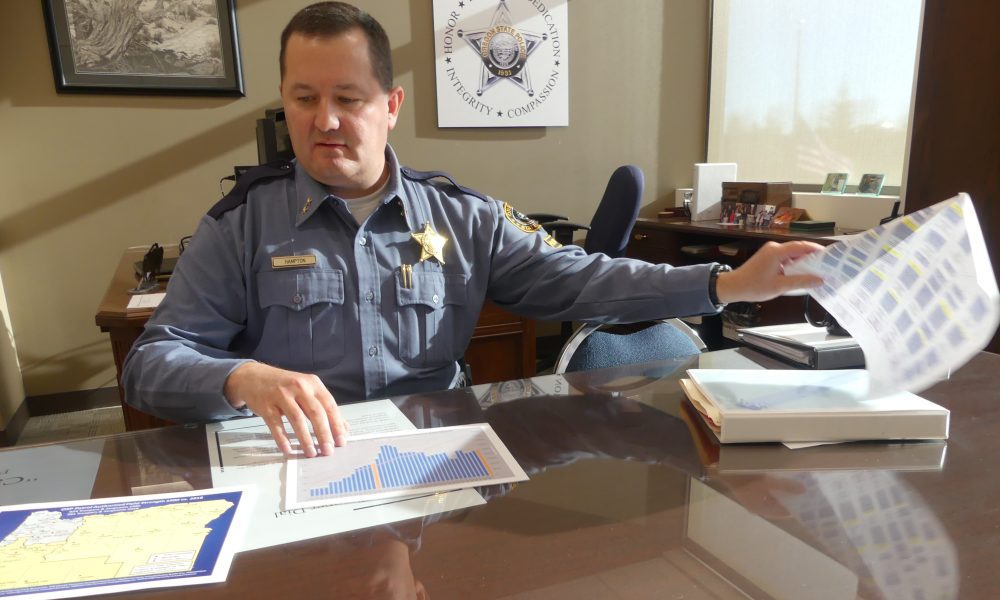
Oregon State Police Superintendent Travis Hampton flips through charts and graphs showing the impacts of OSP’s short staffing. In 2017, the agency was unable to respond to 11,880 calls for service due to staffing levels. (Aubrey Wieber/Salem Reporter)
For 26 years, Travis Hampton worked out of patrol offices for Oregon State Police. Year after year, he saw calls and car accidents increase as the disparity between the population and number of troopers grew.
Sitting in those offices, he thought about the work he would do if he ever climbed to the top of the ranks.
“I always made myself the promise that if I were ever in this position, I would make sure that citizens and legislators knew the dire straits we’re in,” Hampton said.
Hampton is no longer in a patrol post. As State Police superintendent, he’s fulfilled that promise.
Gov. Kate Brown is proposing filling 50 trooper positions in the next state budget that goes into effect next July.
That would be the biggest expansion of the state patrol in recent years. Hampton said that could be the difference in whether a trooper is on shift when you crash your car in rural Oregon or stops a drunk driver on Interstate 5 in the early morning.
As agency’s trooper force dwindled, Hampton has become increasingly vocal about the shortages. He says he’s not comfortable with such advocacy but he’d rather be annoying than cut services or lay people off.
“Virtually my entire career has been a plea for more resources,” Hampton said. Brown appointed him superintendent in 2016.
Hampton, a Gresham native, started with OSP in 1990 when he was 19. He came on 10 years after the state severed the tied between gas tax revenue and OSP’s trooper division.
That meant the state agency had to compete with scores of others for a share of general fund budgets.
Meantime, Hampton saw Oregon’s population rise as the number of troopers lagged. When he started, the state had 512 troopers. Today, it’s budgeted for 454 positions. That’s eight troopers for every 100,000 Oregonians. Only Florida has a lower trooper per capita ratio.
The bottom line of that is troopers can’t respond to every call. In 2017, the agency recorded 11,880 calls for service that it didn’t respond to, or about 33 per day.
State Police officials have pushed for decades for more funding, but never found a governor sympathetic enough to the agency’s shortfalls.
“We really have a champion in Governor Brown, where we have not in the past,” Hampton said.
When Brown announced her budget in late November, Hampton had been told there would be some incremental increases to keep his operation afloat.
He was surprised to hear the funding bump and her plan to double the number of troopers over the next decade.
“I was elated, thankful,” Hampton said. “For the first day I was afraid I was going to wake up and it was a bad dream.”
Hampton started lobbying Brown two and a half years ago when she interviewed him for the job. He hasn’t stopped. Leading up to this budget cycle, he often talked with her staff as she was pursued re-election.
Heidi Moawad, Brown’s public safety advisor, said Hampton was a strong advocate for his agency. He showed her that continuing to run on a slim budget was “untenable.”
The added staffing, Hampton said, means there is a better chance a trooper could respond when someone reports traffic threats, such as a swerving vehicle. More than one trooper might be able to respond to a highway crash to close off the road and provide medical attention. Some patrol stations around the state would return to 24-hour operation.
Now, there are significant gaps.
“You could conceivably enter the state in Ashland on I-5 at 3 in the morning behind a drunk driver and leave the state four hours later in Portland and not have a state trooper on duty the entire length of I-5,” Hampton said.
The state police do more than patrol highways. They manage sex offenders, authorize gun sales, provide forensic services, and conduct fire investigations. When such services need money, Hampton’s usual option is to pull from resources going to troopers and criminal investigations.
He typically gets money by keeping trooper positions empty – about 40.
He endures that cut to patrol services as the state’s population has skyrocketed, putting more cars on the highways. In 2011, there were just over 300 fatal crashes on Oregon roadways. Fatalities peaked in 2016 at 450 and have only slightly lowered since.
Moawad said the state needs more troopers on the highway stopping speeders and responding promptly to accidents.
For years, OSP has lobbied for more funding. In the current budget, the agency was given $6 million for 20 new trooper and detective positions. But it was told to cut other spending by $12 million.
“It’s literally me offering to buy you lunch, then I steal your wallet on the way out,” Hampton said.
Hampton doesn’t know how long he will be on the job. Every four years, the superintendent needs to be approved by the Senate and governor. But if it’s not him, someone else will be fighting for dollars. He has support from Brown, but she will oversee just one more budget.
To stabilize the State Police, Hampton said that by 2030, the state should have 15 troopers per 100,000 Oregonians. And he wants that standard written into law so it never hits the lows he’s experienced.
Hampton’s goal would put Oregon in the middle of the pack nationally on trooper-to-resident ratio.
“That is definitely not the Cadillac,” Hampton said. “That’s the used Honda Accord of policing. Right now, we are in the Pinto.”
Reporter Aubrey Wieber: [email protected] or 503-575-1251. Wieber is a reporter for Salem Reporter who works for the Oregon Capital Bureau, a collaboration of EO Media Group, the Pamplin Media Group, and Salem Reporter.









